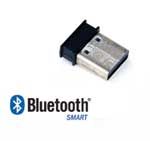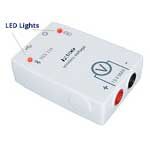Nova Scotia 7-8 Resources
Sensor-based, hands-on activities are very helpful in achieving important objectives of the recently revised curriculum by enhancing authentic learning experiences and investigative science.
Your new PASCO wireless sensors enable students to easily collect, record and analyze data within the SPARKvue software to support an enormous array of investigations. In the classroom, the sensors enhance engagement by providing students with instant and informative feedback as recorded measurements are immediately displayed in graphs, tables, charts and meters.
For longer term classroom and field investigations, many sensors allow for remote data collection, where recorded measurements can be stored in the sensor’s internal memory.

Are your Chromebooks equipped with the right Bluetooth?
Ensure that your Chromebook has a bluetooth dongle inserted into its USB port. Your Chromebook’s internal bluetooth is not capable of communicating with the wireless sensors.

Are your sensors charged?
The temperature, light and conductivity sensors are powered by a replaceable thumb battery. These sensors draw very little power and will likely not need to have their batteries replaced for at least a year.
The pressure, CO2, voltage, and current sensors feature rechargeable batteries that will need to be recharged more frequently. The CO2 sensor requires a considerable amount of power and should be charged before each lab.
To assess the power status of your sensor simply press the power button and note what happens to the LED lights:
Note: To stop the sensor from flashing press and hold the power button for several seconds. Skipping this step will cause the sensor to continue flashing for an extended period which will draw power and may confuse your students.
Charging your sensors
The rechargeable sensors are supplied with a USB cable that can be connected to any standard USB charger. If your sensor is completely flat, plugging your sensor in for 10 or 15 minutes should give an adequate charge for a single lab. The sensor will be fully charged after a couple of hours and will display a solid green LED. A partially charged sensor will have a solid red LED while charging. Leaving the sensor plugged in for extended periods of time may shorten the battery life.
SPARKvue works on Mac & Windows computers, iPads, iPhones, Android tablets and phones
and Chromebooks and the user experience is the same regardless of the platform.

Try it yourself:
Download this SPARKlab file so you can follow along and then try it on your own: Alka-Seltzer & Juice.spk2.
As with all SPARKlabs you must have the SPARKvue app or software installed to open these files.
Samples of Correlated SPARKlab Templates
Here are three sample templates that correlate to the Nova Scotia curriculum.
SPARKlabs are interactive, guided lab activities that use PASCO sensors and software. Below are the activities selected for use in Grades 7-8 using your sensors.
To expand & browse the product lists simply click onto the “title” or the “+/-“.
The SKU number listed is your Nova Scotia ALR number.
| Image | Name | Description | SKU |
|---|
The SKU number listed is your Nova Scotia ALR number.
| Image | Name | Description | SKU |
|---|
Simply check the box at the end of each row, adjust to your desired quantity and then click the add selected to cart button at the bottom.
| Image | Name | Description | SKU |
|---|
The SKU number listed is your Nova Scotia ALR number.
| Image | Name | Description | SKU |
|---|
The SKU number listed is your Nova Scotia ALR number.
| Image | Name | Description | SKU |
|---|
The SKU number listed is your Nova Scotia ALR number.
| Image | Name | Description | SKU |
|---|
I have taught grade 9 applied science, science and technology, grade 10 applied, regular and enriched science, grade 11 chemistry and physics for 33 years at Westwood Senior High School in Hudson Québec. I discovered the PASCO equipment in 2019 and it completely changed my life. I love to discover, produce experiments and share discoveries. I am looking forward to work with your team.
Having graduated with a major in Computer Science and minors in Physics and Mathematics, I began my teaching career at Killarney Collegiate Institute in Killarney, Manitoba in 2009. While teaching Physics there, I decided to invest in PASCO products and approached the Killarney Foundation with a proposal about funding the Physics lab with the SPARK Science Learning System and sensors. While there I also started a tremendously successful new course that gave students the ability to explore their interests in science and consisted of students completing one project a month, two of which were to be hands-on experiments, two of which were to be research based, and the final being up to the student.
In 2011 I moved back to Brandon, Manitoba and started working at the school I had graduated from, Crocus Plains Regional Secondary School. In 2018 I finally had the opportunity to once again teach Physics and have been working hard to build the program. Being in the vocational school for the region has led to many opportunities to collaborate with our Electronics, Design Drafting, Welding, and Photography departments on highly engaging inter-disciplinary projects. I believe very strongly in showing students what Physics can look like and build lots of demonstrations and experiments for my classes to use, including a Reuben’s tube, an electromagnetic ring launcher, and Schlieren optics setup, just to name a few that have become fan favourites among the students in our building. At the end of my first year teaching Physics at Crocus Plains I applied for CERN’s International High School Teacher Programme and became the first Canadian selected through direct entry in the 21 years of the program. This incredible opportunity gave me the opportunity to learn from scientists working on the Large Hadron Collider and from CERN’s educational outreach team at the S’Cool Lab. Following this, I returned to Canada and began working with the Perimeter Institute, becoming part of their Teacher Network.
These experiences and being part of professional development workshops with the AAPT and the Canadian Light Source (CLS) this summer has given me the opportunity to speak to many Physics educators around the world to gain new insights into how my classroom evolves. As I work to build our program, I am exploring new ideas that see students take an active role in their learning, more inter-disciplinary work with departments in our school, the development of a STEM For Girls program in our building, and organizing participation in challenges from the ESA, the Students on the Beamline program from CLS, and our local science fair.
Though I graduated with a BEd qualified to teach English and Social Studies, it just wasn’t meant to be. My first job was teaching technology courses at a local high school, a far cry from the English and Social Studies job I had envisioned myself in. I was lucky enough to stay in that position for over ten years, teaching various technology courses in grades 10-12, while also obtaining a Master of Education in Technology Integration and a Master of Education in Online Instructional Media.
You will notice what is absent from my bio is any background in science. In fact, I took the minimum amount of required science courses to graduate high school. Three years ago I switched roles and currently work as a Technology Integration Leader; supporting teachers with integrating technology into their pedagogy in connection with the provincial outcomes. All of our schools have PASCO sensors at some level (mostly grades 4-12) and I made it my professional goal to not only learn how to use them, but to find ways to make them more approachable for teachers with no formal science background (like me!). Having no background or training in science has allowed me to experience a renewed love of Science, making it easier for me to support teachers in learning how to use PASCO sensors in their classrooms. I wholeheartedly believe that if more teachers could see just how easy they are to use, the more they will use them in the classroom and I’ve made it my goal to do exactly that.
I enjoy coming up with out-of-the-box ways of using the sensors, including finding curriculum connections within subjects outside of the typical science realm. I have found that hands on activities with immediate feedback, which PASCO sensors provide, help students and teachers see the benefits of technology in the classroom and will help more students foster a love of science and STEAM learning.